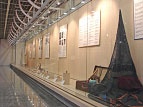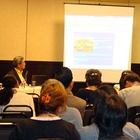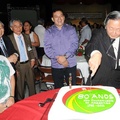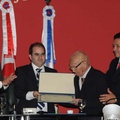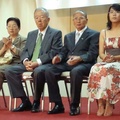As we approach the celebration of the Centenary of Japanese Immigration to Brazil, on June 11, the Museum of the History of Japanese Immigration to Brazil launched the special exhibit, “The Precursor Japanese Immigrants: A Historical Look at the pre-Kasato-Maru Period”.
Held on the museum’s 9th floor, the exhibit focused on three characters that, before the official arrival of the first group of immigrants (brought aboard the Kasato-Maru and sponsored by Ryo Mizumo), were already in – or had ties to – Brazil.
The three stories are those of: Wasaburo Otake, author of the first Japanese/Portuguese dictionary; the Casas Fujisaki Japanese goods store that opened in 1906; and Saburo Kumabe, a judge and lawyer who became an immigrant.
Wasaburo Otake and the first Portuguese-Japanese dictionary
In 1890, Wasaburo Otake arrived in Brazil aboard the cruiser Almirante Barroso, commandeered by Custódio de Mello (later a counter-admiral and Minister of the Navy), and carrying among its officers Prince Augusto Leopoldo (grandson of deposed Brazilian Emperor D. Pedro II).*
On its way around the world, the ship had stopped at the port of Yokohama, where Otake accepted Prince Augusto Leopoldo’s invitation to join the crew. Thanks to Custódio de Mello’s assistance, upon arrival in Rio de Janeiro the 17-year-old Otake was enrolled in the Naval College.
Four years later, Otake returned to Japan. In 1897, following the opening of the Brazilian embassy – at the time called a “Legation” – in Japan, he was hired as an interpreter. He worked at that facility until 1942, when diplomatic ties between Brazil and Japan were severed after Brazil’s entry in World War II.
In 1918, Otake released the first edition of the Diccionario Portuguez-Japonez (Po-Wa Jiten). In 1925, that was followed by the first edition of the Diccionario Japonez-Portuguez (Wa-Po Jiten). In between the two releases, he also published Japanese-language books about Portuguese speech and grammar.
- * Brazil became a republic in 1889.
“Japan in São Paulo”
Confident in Brazil’s potential, in 1906 the businessman Saburosuke Fujisaki IV (from the Sendai region) decided to invest in the country. That year, Fujisaki sent four representatives to São Paulo.
In September 1906, the first branch of the Casas Fujisaki opened its doors on the Rua São Bento in São Paulo’s downtown area. Among the various Japanese goods for sale were silk handkerchiefs, embroidery cloths, flower fabrics, tea, ceramics, bamboo articles, fans, and toys. The initial supply was gone in less than three days.
In the following years, the company invested in the opening of new stores. The headquarters were moved to Rio de Janeiro in 1908, while new branches were opened in Salvador (in Bahia) in 1911 and in Recife (in Pernambuco) in 1912. That same year, a partnership between the Casas Fujisaki and the Comercial Yoshimatsu Matsuura, led to the creation of the Fujimatsu-gumi company in Buenos Aires, Argentina.
In 1924, the company began to invest in agriculture through the acquisition of the 3,185-acre Sapucaia Farm in Pindamonhangaba (approx. 90 miles northeast of São Paulo). In 1926, the company bought another farm in the Pindamonhangaba area, São Pedro, that encompassed 3,600 acres.
The Saburo Kumabe project
On June 18, 1908, when the Japanese immigrants got off the ship Kasato-Maru, Saburo Kumabe’s family and seven other companions had already been trying to make ends meet in Brazil for two years. Unlike most Japanese immigrants at that time – who wished to make money in the new land and then quickly return to their country of origin – Saburo Kumabe, a judge and attorney, wished to remain in Brazil. Thus, he ended up becoming a protagonist of this migratory process.
In 1906, in order to settle the first Japanese colony in Brazil, Kumabe went with his companions to the Santo Antônio Farm near Macaé (in the state of Rio de Janeiro). However, due to a series of unexpected circumstances, in addition to the lack of agricultural know-how on the part of the Japanese, that attempt did not succeed.
Despite financial difficulties, Kumabe invested heavily in the schooling of his daughters: Teru and Toki, the second and third daughters. The daughters ended up receiving their teaching degrees, the highest educational level available for women in those days. In addition, Ry?ichi Yasuda, who in his youth was invited by Kumabe to accompany him to Brazil, had a son, Fábio Ryoji, who became the first Japanese-Brazilian to hold a ministerial post in the country.
* * *
The special exhibit “The Precursor Japanese Immigrants: A Historical Look at the pre-Kasato-Maru Period” took place between June 11, 2007 and August 7, 2007 at the Museum of the History of Japanese Immigration to Brazil.
The Nikkei Album collection “The Precursor Japanese Immigrants: A Historical Look at the pre-Kasato-Maru Period” (Os imigrantes japoneses percursores - Um olhar histórico sobre o período Pré-Kasato-Maru) is based on the above article. Visit the collection and take a look at the photos and objects, and read more details about the Japanese immigrants who arrived in Brazil before the Kasato-Maru.
* The above article is the result of the discussions that took place at the session “Stories of the Nikkei Communities in Latin America” in the workshop organized by Discover Nikkei at the XIV COPANI, held in July 2007 in São Paulo, Brazil, in which representatives from Argentina, Chile, and the United States were also present.
© 2008 Célia Abe Oi


